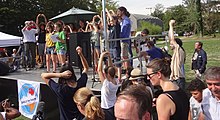Example signals
| Function | Meaning | Gesture | Description | Notes |
|---|---|---|---|---|
| Feeling | Agreement |  | "Up twinkles"; both hands raised with fingers pointing up and being wiggled. | This handsignal was borrowed from the Green Party, who borrowed it from the ASL word for applause. It may be referred to as simply "twinkles". |
| Thumbs up | Some locations use thumb gestures to show approval, neutrality, or disapproval. | |||
| Disagreement |  | "Down twinkles"; arms raised but showing the back of both hands with fingers pointing down and wiggling | One will be asked by the facilitator to clarify one's objection. In Occupy Boston (possibly other sites), down twinkles go by the alternate name of "squid fingers". [12] | |
| Thumbs down | ||||
| Neutral / unsure | Flat hands | One may be asked to clarify one's position. | ||
| Thumb to side | ||||
| Oppose |  | Fist raised | Opposition to the proposal | |
| Hard block |  | Arms up and crossed | Firm opposition to the proposal, a break from the consensus that cannot be supported by this individual. | |
| Speaking | Want to talk |  | Raised, open hand | A person wishes to speak |
| Direct response |  | Both hands moving alternately front to back on each side of the head, directed at an individual | Indicates that critical information was missing from something that was just said. | |
| Clarifying question |  | Single hand formed in the shape of a C | Means that a person has a question that needs to be answered before they can vote on an issue. | |
| Point of process |  | Triangle formed by two hands with the tips of index fingers and of thumbs touching | Conversation has strayed from the original topic. | |
| Wrap it up |  | Both hands moved in a circular motion about each other | Suggests that the speaker should make their points and finish speaking. | |
| Raise the roof | Both hands with palms facing up being moved up and down above shoulder level | Suggests that the speaker should speak up. | ||
Twinkles and down twinkles are referred to as a "temperature check". They indicate if a group is getting close to consensus. Twinkles are also known as "sparkle" or "jazz hands" or spirit fingers. [13]
